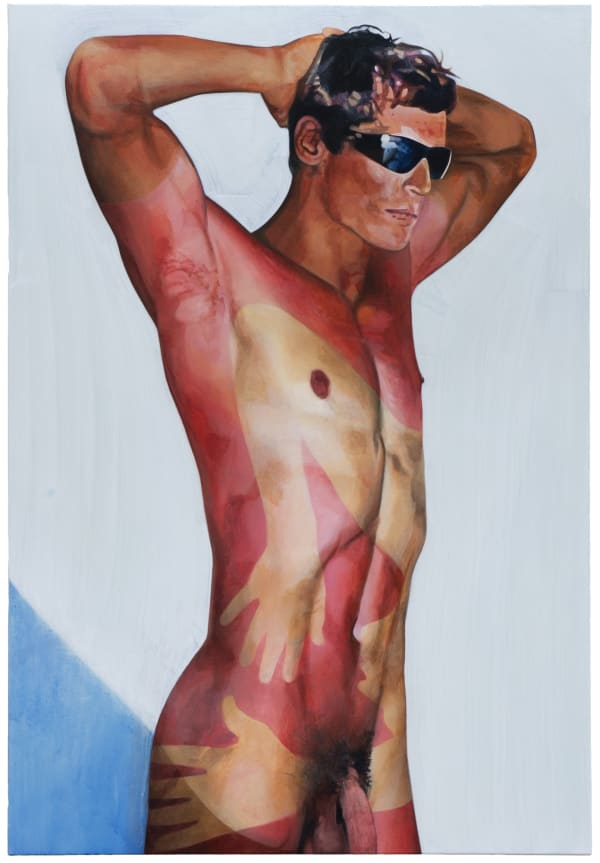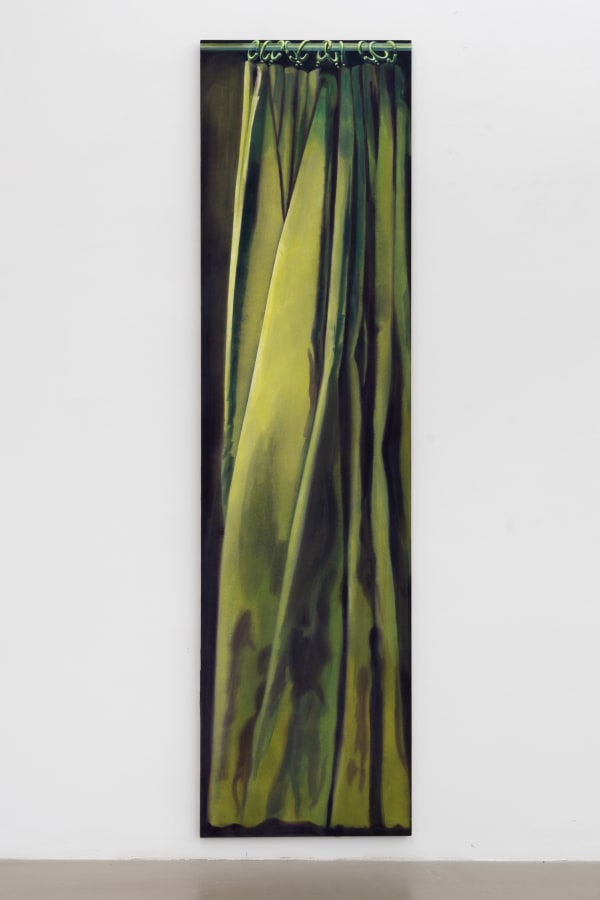-

-
Lin Olschowka’s paintings offer us glimpses of a world that we would not necessarily wish to live in at first glance: the surroundings are cold, the light harsh and the bodies resemble interchangeable objects rather than characterful subjects. One image shows a young, white, conventionally attractive woman in a bikini in an open tanning bed. In another, a glaring beam from a helicopter forms a cone of light in the darkness. Another painting presents the cut, bloody palm of a fleshy hand.
One way of entering the pictorial world Olschowka creates with her paintings on canvas and wood is through the dark green curtain Delft (2023), which the artist borrowed from Jan Vermeer’s Girl Reading a Letter at an Open Window (1657–59). For decades Vermeer’s painting contained a kind of “present absence”, an invisible picture within a picture. In 1979, an X-ray scan revealed that on the wall behind the girl was a portrait of a naked Cupid, the god of love, which had been completely painted over. In 2018, the decision was made to remove this additional layer of paint; an investigation had shown that it could have only been applied after Vermeer’s death. The image within an image has been apparent ever since. “I am interested in pictures within pictures and the act of making them visible,” Olschowka explains. Let’s follow her through the green curtain.
-

-
Most of Olschowka’s paintings are based on screenshots she captures with her mobile phone or computer. Selbstbildnis (2023) also depicts a white female body, this time in a futuristic-looking MRI scanner. The figure is naked, except for a pair of high- heeled shoes, and extremely elongated. The body seems unnatural: the breasts appear stuck on, while the poreless, unwrinkled, unblemished skin is illuminated by artificial neon light in green, yellow, and red – the body as a commodity, in the style of the British pop artist Allen Jones. Everything in this image is smooth, from the surface of the technical equipment to the body and the space surrounding it, which in its emptiness is more reminiscent of outer space than an examination room.
Magnetic resonance imaging, or MRI for short, produces images of the body todetect abnormalities in organs that might indicate disease. Consequently, this technical device not only generates representations of the otherwise invisible interior of the human body; this diagnostic analysis can signify a real turning point in someone’s life by rendering a “present absence” visible. The machine and the artist have something in common in this regard: they both translate the body into images and make something visible that was already there but could not yet be seen or articulated. By structuring the work as a triptych, Olschowka emphasises the spiritual effect of the radiant tube, which almost seems as if it could suck in the body completely and spit it out into another world.
-

-
Olschowka’s images negotiate the relationships between present and future,visibility and invisibility, but also between knowledge and the lack of it: MRI images are not the only method that allow those who possess the knowledge to predict certain interpretations of the future; there are also coffee grounds, as in 5 Artists Who Stole Their Own Career (2023), or the lines on the palm of the hand, which can now – as Fixing Fortune (2023) illustrates – be surgically altered so that the life lines prophesy a more positive future.
In her works, Olschowka responds to the subliminally urgent power of the images that surround us both online and offline, the constant “present absences”, which sheappropriates and situates in new contexts. By playing with the idea of making things visible – also in the sense of discovery and prediction – the painter confronts us with questions such as: What kind of future do we want to live in? Who possesses knowledge? Which present absences occupy our present – and which (perhaps still invisible) turning points do they make possible?
-
Lin Olschowka (b. 1995, Münsterlingen, CH) lives and works in Karlsruhe. She completed her painting studies as a master student under Erwin Gross at the Academy of Fine Arts Karlsruhe in 2021. She recently had a solo exhibition at the Rosgartenmuseum Konstanz. Her works have also been part of numerous group exhibitions at HAMLET (Zurich, 2023), Museum Allerheiligen (Schaffhausen, 2023), Gesellschaft der Freunde junger Kunst Baden-Baden (2022) and Meyer Riegger (Karlsruhe, 2022/2023).
Lin Olschowka, "You've Got Big Hands": Meyer Riegger, Karlsruhe
Past viewing_room












